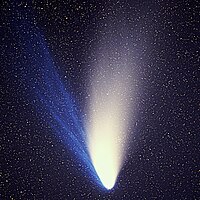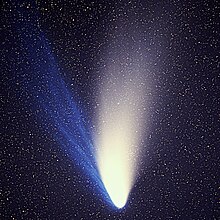ഹെയ്ൽ ബോപ്പ് വാൽനക്ഷത്രം
ഇരുപതാം നൂറ്റാണ്ടിന്റെ വാൽനക്ഷത്രം എന്നറിയപ്പെടുന്ന വാൽനക്ഷത്രമാണ് ഹെയ്ൽ ബോപ്പ് വാൽനക്ഷത്രം. കൂടുതൽ ആളുകൾ ഏറ്റവും കൂടുതൽ ദിവസം കണ്ട വാൽനക്ഷത്രം ഹെയ്ൽ ബോപ്പ് വാൽനക്ഷത്രം ആയിരിക്കും. പതിനെട്ടു മാസത്തോളം ഇതിനെ നഗ്നനേത്രങ്ങൾ കൊണ്ടു കാണാൻ കഴിഞ്ഞിരുന്നു. 1995 ജൂലൈ 23നാണ് ഇതിനെ കണ്ടെത്തുന്നത്. സൂര്യനോട് ഏറ്റവും അടുത്തെത്തിയത്(ഉപസൗരം)1997 ഏപ്രിൽ ഒന്നിനും. ഇന്റർനാഷണൽ അസ്ട്രോണമിക്കൽ യൂണിയൻ ഇതിന് C/1995 O1 എന്ന പേരു നൽകി. അലൻ ഹെയിൽ, തോമസ് ബോപ് എന്നീ അമേരിക്കൻ ശാസ്ത്രജ്ഞരാണ് പരസ്പരം അറിയാതെ തികച്ചും സ്വതന്ത്രമായി ഈ ധൂമകേതുവിനെ കണ്ടെത്തിയത്. അതുകൊണ്ട് ഇതിന് രണ്ടുപേരുടെയും പേർ ചേർത്ത് ഹെയ്ൽ ബോപ്പ്(Hale–Bopp) എന്നു നാമകരണം ചെയ്തു.[5] വലിയ ധൂളീവാലിന് പുറമെ ഒരു പ്ലാസ്മാ വാലും ഇതിനുണ്ടായിരുന്നു. C/1995 O1 എന്നാണ് ഇതിന്റെ ശാസ്ത്രനാമം.
 Comet Hale–Bopp, shortly after passing perihelion in April 1997 | |
| Discovery | |
|---|---|
| Discovered by | Alan Hale Thomas Bopp |
| Discovery date | July 23, 1995 |
| Alternative designations | The Great Comet of 1997, C/1995 O1 |
| Orbital characteristics A | |
| Epoch | 2450460.5 |
| Aphelion | 370.8 AU[1] |
| Perihelion | 0.914 AU[1] |
| Semi-major axis | 186 AU |
| Eccentricity | 0.995086 |
| Orbital period | 2520[2]–2533[1] yr (Barycentric 2391 yr)[3] |
| Inclination | 89.4° |
| Last perihelion | April 1, 1997[1] |
| Next perihelion | 4385 ± 2.0 AD[4] |

സൂര്യനിൽ നിന്നും 7.2അസ്ട്രോണമിക്കൽ യൂണിറ്റ് അകലെ വ്യാഴത്തിനും ശനിക്കും ഇടയിലായിരിക്കുമ്പോൾ തന്നെ ഭൂമിയിൽ നിന്നും നിരീക്ഷിക്കാൻ സാധിച്ചിരുന്നു.[6][7] സാധാരണ ഈ അകലത്തിൽ ധൂമകേതുക്കൾ വളരെ മങ്ങിയതായിരിക്കും. പക്ഷെ ഹെയിൽ-ബോപിന്റെ കോമ ഈ അകലത്തായിരിക്കുമ്പോഴും ഭൂമിയിൽ നിന്നും നിരീക്ഷിക്കാൻ കഴിഞ്ഞിരുന്നു.[8] ഹാലിയുടെ ധൂമകേതു ഇതേ അകലത്തായിരുന്നപ്പോൾ ഹെയ്ൽ ബോപ്പിനെക്കാൾ നൂറിലൊന്നു തിളക്കമേ ഉണ്ടായിരുന്നുള്ളു.[9] പിന്നീടുള്ള പഠനങ്ങളിൽ നിന്ന് ഇതിന്റെ ന്യൂക്ലിയസിന് ഏകദേശം അറുപത് കി.മീ വ്യാസമുള്ളതായി കണ്ടെത്തി. ഇത് ഹാലി ധൂമകേതുവിന്റെ വ്യാസത്തിനെക്കാൾ ആറു മടങ്ങ് കൂടുതലായിരുന്നു.[1][10]
അവലംബം
തിരുത്തുക- ↑ 1.0 1.1 1.2 1.3 1.4 "JPL Small-Body Database Browser: C/1995 O1 (Hale–Bopp)" (2007-10-22 last obs). Retrieved 2008-12-05. ഉദ്ധരിച്ചതിൽ പിഴവ്: അസാധുവായ
<ref>ടാഗ്; "jpldata" എന്ന പേര് വ്യത്യസ്തമായ ഉള്ളടക്കത്തോടെ നിരവധി തവണ നിർവ്വചിച്ചിരിക്കുന്നു - ↑ Syuichi Nakano (2008-02-12). "OAA computing section circular NK 1553". OAA Computing and Minor Planet Sections. Retrieved 2009-12-17.
- ↑ Horizons output. "Barycentric Osculating Orbital Elements for Comet C/1995 O1 (Hale-Bopp)". Retrieved 2011-01-31. (Solution using the Solar System Barycenter and barycentric coordinates. Select Ephemeris Type:Elements and Center:@0)
- ↑ "Solex 10 estimate for Next Perihelion of C/1995 O1 (Hale-Bopp)". Archived from the original on August 10, 2012. Retrieved 2009-12-18.
- ↑ Shanklin, Jonathan D. (2000). "The comets of 1995". Journal of the British Astronomical Association. 110 (6): 311. Bibcode:2000JBAA..110..311S.
- ↑ Marsden, B. G. (1995). "Comet C/1995 O1 (Hale-Bopp)". Minor Planet Electronic Circular. 1995-P05.
- ↑ Kidger, M. R.; Serra-Ricart, Miquel; Bellot-Rubio, Luis R.; Casas, Ricard (1996). "Evolution of a Spiral Jet in the Inner Coma of Comet Hale-Bopp (1995 O1)". The Astrophysical Journal Letters. 461 (2): L119–L122. Bibcode:1996ApJ...461L.119K. doi:10.1086/310008.[പ്രവർത്തിക്കാത്ത കണ്ണി]
- ↑ Hale, A. (July 23, 1995). "IAU Circular No. 6187". IAU. Retrieved 2011-07-05.
{{cite web}}: Unknown parameter|coauthors=ignored (|author=suggested) (help) - ↑ Biver, N.; Rauer, H; Despois, D; Moreno, R; Paubert, G; Bockelée-Morvan, D; Colom, P; Crovisier, J; Gérard, E (1996). "Substantial outgassing of CO from Comet Hale–Bopp at large heliocentric distance". Nature. 380 (6570): 137–139. Bibcode:1996Natur.380..137B. doi:10.1038/380137a0. PMID 8600385.
- ↑ Fernández, Yanga R. (2002). "The Nucleus of Comet Hale-Bopp (C/1995 O1): Size and Activity". Earth, Moon, and Planets. 89 (1): 3–25. Bibcode:2000EM&P...89....3F. doi:10.1023/A:1021545031431.[പ്രവർത്തിക്കാത്ത കണ്ണി]